
How to thresh amaranth
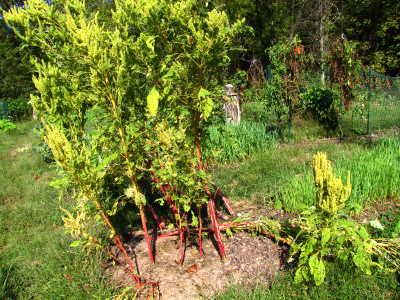 Our
quinoa disappeared into a deer- and bug-eaten mess this spring, but our
amaranth
sprang up far above my head. By late summer, the plumes of
flowers were going to seed, and the red stalks were four inches in
diameter. Clearly, the growing part of our amaranth experiment
was a success. (This photo was taken near the end of September
when the plants were mostly mature. Next year, I'll give them
some supports, since about half of the plants fell over under the
weight of their fruits.)
Our
quinoa disappeared into a deer- and bug-eaten mess this spring, but our
amaranth
sprang up far above my head. By late summer, the plumes of
flowers were going to seed, and the red stalks were four inches in
diameter. Clearly, the growing part of our amaranth experiment
was a success. (This photo was taken near the end of September
when the plants were mostly mature. Next year, I'll give them
some supports, since about half of the plants fell over under the
weight of their fruits.)
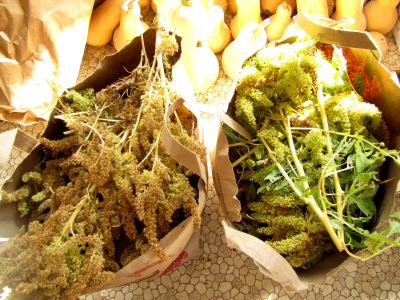 After the first frost, I
snipped off all of the plumes with scissors and stuffed them into two
paper grocery bags. Although I've read that it's easier to thresh
your amaranth if you let the seed heads dry thoroughly first, I didn't
have space to spread the plumes out and I was a bit afraid of them
molding in their bags. So I moved on to processing the grain.
After the first frost, I
snipped off all of the plumes with scissors and stuffed them into two
paper grocery bags. Although I've read that it's easier to thresh
your amaranth if you let the seed heads dry thoroughly first, I didn't
have space to spread the plumes out and I was a bit afraid of them
molding in their bags. So I moved on to processing the grain.
When I researched
homegrown grains last winter, the accepted method for home-threshing
seemed to be to lay out your heads of grain on an old sheet and whack
them into submission with a stick or plastic bat. The more I
thought about this idea, the more it seemed like I'd end up with grain
everywhere except on the sheet. Plus, we're kinda low on sheets.
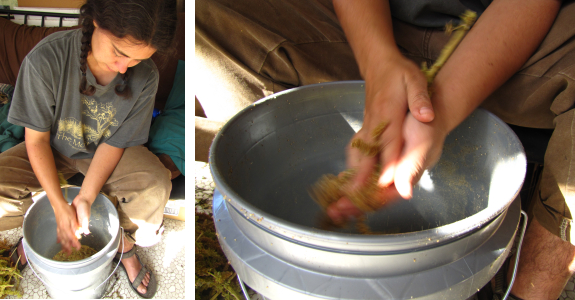
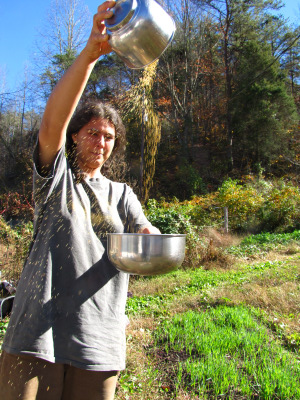 There
are several other methods people use to thresh grain at home, but as
small as our experimental harvest was, it seemed easier to go with a
more time-consuming method that required no elaborate setup. I
just rubbed the plumes one by one between my hands, letting the seeds
fall into a clean bucket.
There
are several other methods people use to thresh grain at home, but as
small as our experimental harvest was, it seemed easier to go with a
more time-consuming method that required no elaborate setup. I
just rubbed the plumes one by one between my hands, letting the seeds
fall into a clean bucket.
To winnow, I headed
outside with two bowls and poured my grain from one to the other until
the breeze had carried away all of the chaff. (The chaff mostly
ended up on Lucy's head since she came to sit at my feet like any
faithful dog would.) As I got more confident, I lifted the bowl
higher and higher, until I could see the beautiful rain of seeds
falling directly downward to ping in my metal bowl, while the light
chaff floated away in another column.
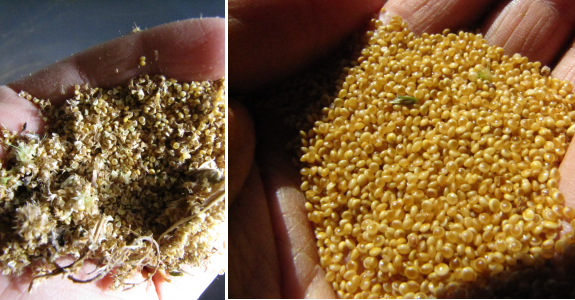
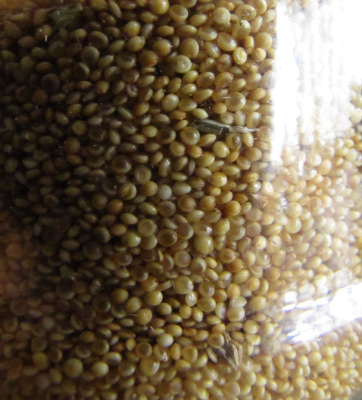 There were a few bits of
chaff left in my bowl even after several rounds of winnowing, pieces of
seedhead that were about as heavy as the seeds themselves. Some
people pass their seeds through a windowscreen at this point, but I
just picked out the half dozen big pieces and moved on. The
photos above show my amaranth before (left) and after (right) winnowing.
There were a few bits of
chaff left in my bowl even after several rounds of winnowing, pieces of
seedhead that were about as heavy as the seeds themselves. Some
people pass their seeds through a windowscreen at this point, but I
just picked out the half dozen big pieces and moved on. The
photos above show my amaranth before (left) and after (right) winnowing.
I threshed and winnowed
about a quarter of our harvest and came up with a cup of seeds. I
figure a quart of the tiny seeds is a pretty good haul for one
experimental bed of amaranth. Next step: to see if we like the
taste.
Want more in-depth information? Browse through our books.
Or explore more posts by date or by subject.
About us: Anna Hess and Mark Hamilton spent over a decade living self-sufficiently in the mountains of Virginia before moving north to start over from scratch in the foothills of Ohio. They've experimented with permaculture, no-till gardening, trailersteading, home-based microbusinesses and much more, writing about their adventures in both blogs and books.
Want to be notified when new comments are posted on this page? Click on the RSS button after you add a comment to subscribe to the comment feed, or simply check the box beside "email replies to me" while writing your comment.
- Remove comment
